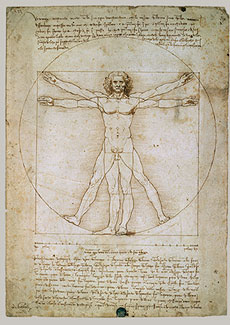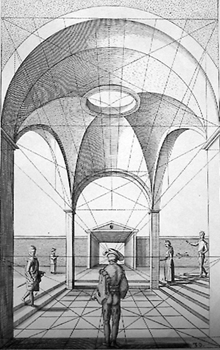In
the Renaissance period artists gave considerable attention to the design
of their images. During this period artists began using vanishing points
and single point perspective - this came about through the use of the camera obscura - If you want to know more, track down a copy
of David Hockney's - Secret Knowledge - DVD which explains
this very well.

Gallerie
dell'Accademia, Venice
The Vitruvian Man, ca. 1492
Leonardo da Vinci (Italian, 1452–1519)
Pen and ink; 13 1/2 x 9 5/8 in. (34.3 x 24.5 cm)
|

Mouse over this De Vries image, look how the image is based on thirds and the vanishing point is where the dominant figures head is .
|
Italian Renaissance
architects based their theories and practices on Classical Roman examples.
The Renaissance revival of Classical Rome was as important in architecture
as it was in literature. A pilgrimage to Rome to study the ancient buildings
and ruins, especially the Colosseum and Pantheon, was considered essential
to an architect's training. Classical orders and architectural elements
such as columns, pilasters, pediments, entablatures, arches, and domes
form the vocabulary of Renaissance buildings. Vitruvius's writings on
architecture also influenced the Renaissance definition of beauty in
architecture. As in the Classical world, Renaissance architecture is
characterized by harmonious form, mathematical proportion, and a unit
of measurement based on the human scale.
During the Renaissance, architects
trained as humanists helped raise the status of their profession from
skilled laborer to artist. They hoped to create structures that would
appeal to both emotion and reason.
Understanding such
issues allows us to use them as visual strategies in our image making.